
![]()
Search the Journey to Forever website – click HERE
|
Journey to Forever: Make a donation |
Navigation
Contact usTo Keith Addison Handmade Projects |
Schools participation
"The earth was not given to us by our parents,
it was loaned to us by our children."
– Kenyan proverb
Schoolchildren are a special part of Journey to Forever – participation is open to schools everywhere, and it's free.
Schoolchildren can share our adventures via the World Wide Web. They'll find themselves working over the Internet to help us solve real problems affecting the lives of real people.
Participation won't be just a token: if schools groups think we're doing something wrong and they've got a better idea, then we'll do it their way!
IT education is at the core of the project: students will use information technology in new and creative ways, while linking and collaborating with children in other lands, sharing views, making new friends, and learning together.
-- "Information Technology is not a subject – it is a whole new educational culture." -- Au Pak Kuen, Vice-president, Hong Kong Professional Teachers' Union
-- "I've learnt more than I ever could from a book!" – comment by AT&T Virtual Classroom student
Journey to Forever has "viewer appeal" – the sense of an unfolding adventure, interactive communications, and a highly involving content make learning fun, and easy. And children care about the issues we're involved in. We'll help them make a difference.
Schools project structure
Schools can participate at three levels:
- the environment and development projects we'll be working on in the field
- special schools projects related to our main work
- background studies
This provides an ongoing series of linked schools projects catering for all levels and covering a wide range of subjects, with background and other resources provided online.
The team's professional writers and photographers will produce the project material and deliver it via high-speed mobile satellite link to our co-ordination centre, which will run the Journey to Forever Website and manage schools resources.
The communications link will work both ways, providing interactive participation in all phases of the expedition via Internet forums and online "chat" discussions, and even real-time video conferencing. Via satellite link, we'll take participating schoolchildren into classrooms in villages very far from anywhere.
We'll also foster community and school projects in centres along the route, such as energy and environment projects, waste-recycling and urban farms, and we'll set up information-sharing networks between different centres, involving local schools and all our school participants.
Where sponsorship is available, we'll arrange for small groups of students to join the expedition for short periods, gaining actual field-experience.
-- "The most effective way of all to teach kids about what life is like in developing countries is to take them there. We've done that before and it was quite remarkable, it really was a life-changing experience." – John Sayer, Director, Oxfam Hong Kong
Languages
The main project language is English, and for non-native speakers all schools projects can be used to enhance English-language teaching.
However, we do not want the project closed to all but English-speaking students. We're now building sister-Websites in other languages, and investigating translation options.
We already have a Japanese website, the Spanish site is growing fast, with a new Portuguese site following, and we'll add others as we can.
Journey to Forever Japanese site
En español - Biocombustibles, biodiesel
Schools projects
(All our school projects include IT education.)
Biofuels
Solar box cookers
Backpack stove
PicoTurbine
Low-tech radio
What to do with a cardboard carton
Sisters of silk
Silkworms in a shoebox
School gardens
School composting
Trees and forests
The Beach House fish pond
HOMeR -- Handmade Organic Mosquito repellent
Eco-footprint
School and youth programs on the Web
Education resources on the Web
Biofuels
Our work with biofuels has four main aims:
- Finding clean, renewable fuels for our vehicles;
- Helping to find ways to clean up the air in polluted cities;
- As an environmental project for schools participating in Journey to Forever;
- As a means of improving energy self-reliance in rural communities.
– how to make the school bus exhaust smell like French fries Cities are choking on air-pollution, and one of the main culprits is the exhaust smoke from diesel engines. What about the pollution from car engines? Most cars have petrol engines (gasoline), not diesel, and they don't smoke as much, but they still pollute the air with deadly fumes. Biofuels Half the inhabitants of Earth cook over woodfires -- 45% of the world's wood is used as fuel. And nearly 2.4 billion people are now facing shortages of fuelwood. Meanwhile deforestation helps cause climate change, floods and soil erosion, increasing environmental degradation, and increasing poverty and hunger. Solar box cookers for schools Here's how to make a camping stove for your backpack that weighs just about nothing and takes up hardly any space. This is a great energy project! Make a miniature, 8" (20 cm) high, wind-driven power generator. Midori made one out of a pencil, a wire coat-hanger, a bit of wood, an old CD, some paper and cardboard, four magnets, and some other bits and pieces. Listen to AM radio on a crystal radio set you can build yourself for only a few dollars. Crystal radios don't need a power supply -- they're powered by the radio waves they receive! Which is best? There are lots more, this list will keep growing -- can you add to it? What to do with a cardboard carton -- Hong Kong's Chinese amahs
Other communities have started to use our Sisters of Silk project as a model for similar work in their own societies. The context is quite different, but the model is easily adapted to new tasks. Sisters of silk -- Hong Kong's Chinese Amahs -- part of the Sisters of Silk project Projects: Silkworms in a shoebox Handmade Projects' innovative organic growing system is ideal for schools gardens and as a resource for school biology and environment projects. This system can even be adapted to conditions in Hong Kong schools which don't have school grounds.
All gardening projects integrate well with the rest of the curriculum and enhance studies in a wide range of subjects. Kids love composting and vermicomposting projects! Gardening and composting go hand-in-hand, especially in school garden projects: gardening without composting only teaches half the lesson. Without trees, we are doomed. Nothing symbolises Mother Nature and how our environment is threatened better than trees and forests, and especially rainforests. Via the Internet, schools and children can get actively involved in saving trees -- and learning in depth exactly why it's so important. Trees and forests -- resources for schools "Aren't you breeding mosquitoes in that bathtub? Why're you growing water hyacinth? It's a terrible pest." -- Craig Leeson, journalist. This project has a lot of depth -- more depth than our fishpond (which has no fish...). Beach House Fish pond The Thai lemon grass in our herb garden grows nearly two inches a day -- and we found it keeps the mosquitoes away. We've also found that it's an effective herbal anti-fungal medicine (lemongrass tea) and in Puerto Rico people use the fibrous stalks as a natural toothbrush! But how can its essence be extracted and preserved without losing its magic? We use a tincture we make with Chinese brandy. It works well -- but can you find a better way? "The world's most dangerous animal is the mosquito." -- BBC World Service health program: millions die every year of malaria, and with increasing drug resistance, the problem is worsening, while attempts to control the mosquitoes with pesticides have proved ineffective. Handmade Organic Mosquito Repellent (HOMeR) page Are you too big for your boots? How heavily do you tread upon the world? These are the major international programs for schools and students on the Internet. Schools and youth programs on the World Wide Web Search engines, libraries, resources, thousands of schools projects, games, communications -- for teachers, for students and for kids.
Biodiesel and ethanol are clean, grow-your-own fuels made from plants, and they can be made in small villages, in a kitchen, or in a school laboratory. The wonderful thing about these fuels is that the by-products can still be used as food products, so no one has to starve because we're making fuel instead of food. We'd be making both!
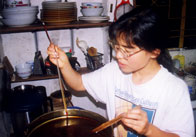
Making biodiesel in the kitchen.Biodiesel
But diesels are the most economical engines by far, and transport industries rely on them. Scrapping diesels would raise the costs of just about everything and make everyone's life tougher.
There is one solution which could bring immediate benefits -- biodiesel. Biodiesel is a clean, environmentally friendly diesel fuel, "more biodegradable than sugar, less toxic than table salt".
We make our own biodiesel -- out of used cooking oil! You can make it too, in the school laboratory. See:
Make your first test batch of biodiesel -- Start here, and just keep going -- what you need, what to do, how to do it, everything you need to know -- step by step instructions for making high-quality biodiesel fuel, from novice to advanced level.
Cooking oil candles
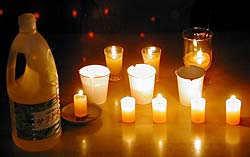
We've worked with many school teachers here in Japan wanting to include biodiesel in their lessons. We did a biodiesel project with the science teacher at our local village school here in Tamba. The kids brought used cooking oil ("tempura oil") from their kitchens at home. We collected it the day before and titrated each batch (all had low titration levels -- healthy kitchens!). We divided the oil into three batches.
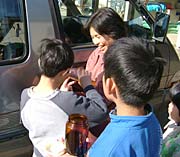
The next day at the school we made biodiesel with one batch, using this Test-batch processor. With the second batch, the children poured it straight into the fuel tank of our Toyota TownAce van (it has an Elsbett SVO system from Germany and runs on either biodiesel or straight vegetable oil or both). Then we took them for a short drive, and several teachers came along too -- they were delighted with the idea, especially the kids.
Back at the school, we made the last batch of oil into candles. There's a cheap product you can buy here in a supermarket, a white powder made from 100% castor oil which you add to your used cooking oil when you're finished with it, while it's still hot, stir it up and it sets into a solid gel which you can add to the burnable garbage bin rather than throwing it down the drain or the toilet. The powder is Castor wax (Hydrogenated Castor Oil or "Trihydroxystearin").
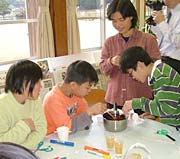 The gel also makes good candles -- they're easy to make and they burn well, without any odour (it needs three strings for the wick, one doesn't work so well). Another good lesson: the kids took their waste oil candles back home again and burned them with their families on Candle Night at the winter solstice:
The gel also makes good candles -- they're easy to make and they burn well, without any odour (it needs three strings for the wick, one doesn't work so well). Another good lesson: the kids took their waste oil candles back home again and burned them with their families on Candle Night at the winter solstice:
http://www.candle-night.org/
Teachers can easily develop their own lesson plans from the tried-and-true methods in our Biodiesel section -- start here:
"Where do I start?"
Tiny diesel engines
Diesel model aircraft engines range from 0.55 cc (0.033 cu in) up to about 8 cc (0.48 cu in). They fit in the palm of your hand and weigh about 250 grams (9 oz) -- great for demonstrations and student projects.
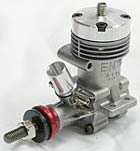
Enya's famous .15 series diesel, from Japan
These are great little engines, beautifully engineered, true compression-ignition diesels. Some of them reach 18,000 rpm.
Most models have radio control versions (remote control, R/C).
They will run on biodiesel, but not 100% biodiesel. Their standard fuel is a mixture of 30% castor oil, 40% kerosene and 30% ether. You can substitute biodiesel for the castor oil and kerosene, but it still needs the ether -- 70% biodiesel and 30% ether.
Read more, where to buy: see Tiny diesel engines.
Other resources
Education Resources at the US Alternative Fuels Data Center: "This site contains valuable information about alternative fuels and vehicles for teachers and students in kindergarten through 12th grade. Students in grades K through 12 can find fun activities, workbooks, and competitions that enhance their science studies. Elementary, middle school, and high school teachers will find a wide array of curriculum ideas to help their students understand the alternatives to fossil fuels and internal combustion engines."
http://www.eere.energy.gov/afdc/resources/educational_tools.html
US Energy Information Administration Kid's Page -- Biodiesel, a Renewable Fuel: Energy facts, Fun & games, Energy history, Classroom activities, features Biodiesel Made from Vegetable Oils and Animal Fats, Biodiesel as a Transportation Fuel, Biodiesel and the Environment:
http://www.eia.doe.gov/kids/energyfacts/sources/renewable/biodiesel.html
The "related links" page offers a wide variety of online energy education resources, not all in the US (beware of "greenwash")
http://www.eia.doe.gov/kids/onlineresources.html
New York's "School Power...Naturally" program offers online lesson plans for grades 5 through 12, focuses mainly on solar PVs, but with lessons on Energy Misconceptions, Dependence on Fossil Fuels, The Carbon Cycle, The Greenhouse Effect, Biomass Energy and others.
http://www.powernaturally.org/Programs/SchoolPowerNaturally
/InTheClassroom/default.asp?i=9
Level 2 Lessons
http://www.powernaturally.org/Programs/SchoolPowerNaturally/
InTheClassroom/level2.asp?i=9
Level III Lessons
http://www.powernaturally.org/Programs/SchoolPowerNaturally/
InTheClassroom/level3.asp?i=9
Incorporating Lessons on Biodiesel into the Science Classroom, Michael S. Briggs, Joseph Pearson, Ihab H. Farag, University of New Hampshire (UNH), USA -- Presentation at the NH Science Teacher Association (NHSTA) Annual Conference, 2004 (PowerPoint file)
http://www.unh.edu/p2/biodiesel/media/NHSTA.ppt
US National Energy Education Development (NEED) Energy Infobook Activities at the Primary, Intermediate and Secondary levels, online lessons in Acrobat format -- Curriculum Guides and Activities
http://www.need.org/info_act.htm
Biodiesel resources at Journey to Forever:
Biofuels
En español -- Biocombustibles, biodiesel
Biofuels Library
Biofuels supplies and suppliers
Biodiesel
Make your own biodiesel
Mike Pelly's recipe
Two-stage biodiesel process
FOOLPROOF biodiesel process
Biodiesel processors
Biodiesel in Hong Kong
Nitrogen Oxide emissions
Glycerine
Biodiesel resources on the Web
Do diesels have a future?
Vegetable oil yields
Washing
Biodiesel and your vehicle
Food or fuel?
Biodiesel pages in Spanish
Ethanol
Ethanol is a good substitute for petrol: it's a clean, high-performance fuel that cuts poisonous exhaust emissions and is much better for the environment.
Ethanol is made by fermenting and then distilling starch and sugar crops. Here's how to make it in the school lab:
"Ethanol -- As A Fuel", comprehensive study project from the Northwest Iowa Community College, including laboratory production of ethanol. Ethanol Curriculum for Teachers (Grades 9-12)
http://www.nwicc.cc.ia.us/etsp.htm
Ethanol from plants -- Ethanol Study Course, resources for teachers, from Australia's New South Wales Higher School Certificate (Stage 6) syllabus
http://www.kcpc.usyd.edu.au/discovery/9.2.3-short/syllabus.html
Ethanol Car: Building the ‘Stirly, the Little Engine that CAN’ -- Stirly was designed as an educational model to demonstrate how biomass fuels (clean and renewable fuels made from plant materials) can be used to power vehicles. It is meant to inspire people into thinking about alternatives to fossil fuel energy. It is also meant to promote a very exciting and promising sustainable technology for not only locomotion, but also heating, cooling, and power generation, namely, the Stirling engine. here's how to build a Stirly, using a tin can, a few balloons, a rubber band, a paper clip, a hoseclamp, a fondue burner, some copper wire, fishing line, bits of wood and plastic and other stuff, duct tape and Superglue.
http://www.eya.ca/mainresources/energymodels/biomass/ethanolcar.htm
Build A Tin Can Stirling Engine -- by Mr.Saburo Tsucchida of Kasukabe technical high school in Japan. Full instructions and diagrams.
http://www.bekkoame.ne.jp/~khirata/english/mk_can.htm
Energy Quiz -- from the Energy Information Administration, US Department of Energy: 15 multiple-choice questions with "Find the answer first or look at the Quick Answer List."
http://www.eia.doe.gov/kids/energyquiz.html
Fuels and Society -- General Chemistry Case Study Curriculum Supplements:
a. Chemistry and History of Automotive Fuels
b. Sixty Years of Tetraethyllead
c. How Lead was Finally Removed from Gasoline
http://chemcases.com/
The Secret History of Lead -- Special Report, by Jamie Lincoln Kitman : 27,000-word investigative report, The Nation March 20, 2000
http://www.globalleadnet.org/advocacy/initiatives/nation.cfm
More ethanol resources here.
Biofuels Library
Biofuels supplies and suppliers
Ethanol
Ethanol resources on the Web
Is ethanol energy-efficient?Solar box cookers
There's one simple answer to these problems, that can save millions of trees, provide clean, safe drinking water, doesn't smoke, and that costs just about nothing -- solar box cookers, made from cardboard cartons.
Solar rice for lunch! Free energy!
Solar box cookers
Solar cooker resources on the webBackpack stove
 These little stoves are great -- they're fun to make and it only takes a few minutes. Not just a toy -- they really work! They put out a hot ring of blue flame like a gas stove and hold enough fuel for about 15 minutes -- so if you're cooking something that takes longer than that, better make two so you can alternate them to keep up the heat.
These little stoves are great -- they're fun to make and it only takes a few minutes. Not just a toy -- they really work! They put out a hot ring of blue flame like a gas stove and hold enough fuel for about 15 minutes -- so if you're cooking something that takes longer than that, better make two so you can alternate them to keep up the heat.
All you need is a couple of aluminium soft-drink cans, some perlite, a wire coat-hanger and a bottle of denatured alcohol (spirits, usually dyed purple).
Backpack stove -- full instructions.
Make a Hobo stove with a one-gallon paint can and a pocket knife.PicoTurbine
Or you can buy a special kit. "The PicoTurbine can produce 1/3 watt -- that's a lot of power when converted to education!"
PicoTurbine pageLow-tech radio
Crystal radios were discovered in 1901 and are still the basis for most modern-day radio apparatus. For this reason, a study of crystal sets is a great place to start to build a foundation in radio electronics.
Building them was a craze in the 1920s, and again in the 1950s, and now it's happening all over again.

You can make a crystal radio out of anything (Xtal Set Society)
Here's where to start: online resources, plans and instructions for different models you can build -- from a cereal packet, a cigar box, and a computer cable.
What to do with a cardboard carton
We started another list like this, listing the ways people use empty oil drums, but we soon gave up -- it would be too long!
Why don't you try it? See how many empty oil drums you can spot being used for different purposes in your neighbourhood -- it will help you to open your eyes to recycling opportunities. They're the big, 55-gallon (US) steel drums. They're everywhere, but nobody notices them.
Let us know what you find -- we'll keep count.Sisters of silk
Chinese "amahs" (domestic helpers) first gained their economic independence through the silk boom in the rural areas of Guangdong at the start of this century. When the silk boom ended, they formed sisterhoods, took anti-marriage vows, and devoted themselves to domestic service.

Drawing by Christine Thery
Now there are only a few of them left, and the fascinating history of these women and their unique way of life will soon be lost forever.
A social research and oral history project mainly for Hong Kong schools to help capture a special part of local history before it fades away.
Is there a part of living history in your community that's fading away, a group of old people whose lives were part of something special that's now past? Don't let their memories die, show them you care. Please contact us, we'll help you if we can.Silkworms in a shoebox
Mulberry trees
Kids' crazesSchool gardens
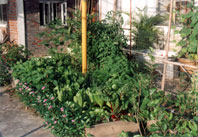
Journey to Forever garden
The garden at our Hong Kong headquarters, the Beach House on Lantau Island, demonstrates that you can build a beautiful organic food garden on top of cement without any soil -- you make your own high-quality soil by recycling food scraps and waste.
Hundreds of great projects, online and in books.
See School gardens page
School gardening resources
Trees and forests -- resources for schools
School composting
Composting concerns the invisible half of the Wheel of Life, Nature's cycle of growth and decay. This is the vital part that happens underground, where wastes decay to give rise to new life.
The complete lesson from which children can benefit the most includes the full round of growth and decay, how the one depends on the other, and how, together, they compose a vivid example of the health, balance and sustainability of a natural system at work.
Great schools composting resources online. Trees and forests
Here are the best resources available:The Beach House fish pond
Projects:
Garden pond
Aquaculture for small farmersHandmade Organic Mosquito Repellent (HOMeR)
Subjects:
Eco-footprint
Your ecological footprint is the amount of land it takes to support your way of life, your lifestyle.
The worldwide average per capita footprint is 2.4 hectares, or 6 acres. If we leave only 12% of the biosphere for other species, there are less than 2 hectares available per person, or 5 acres each -- this means that we humans overshoot the mark by at least 20%.
That's a very important number -- it's the measure of just how "unsustainable" we are. This is why environmental issues are so important.
Let's see how you measure up. Includes guidance on how to make your footprint smaller. Schools programs
Schools resources